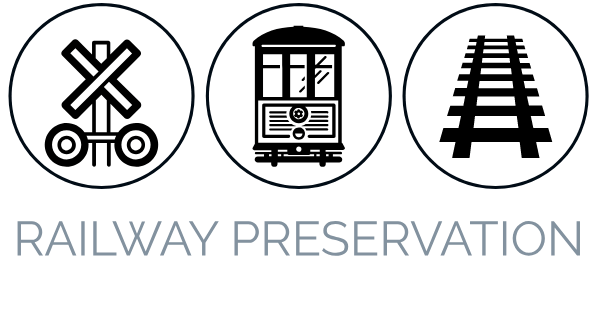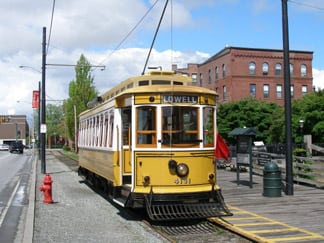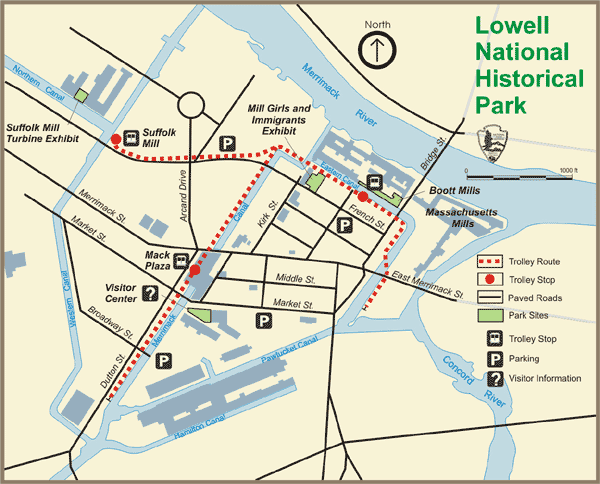U.S. Streetcar Systems- Massachusetts – Lowell
Lowell
Began Operation: 1984
Route Miles: 1
Stops: several
Organization: National Park Service
Schedule: daily, March-November
Photo: John Smatlak
Located just 30 minutes north of Boston, the Lowell National Historic Park (LNHP) uses three replica and one restored original trolley to circulate visitors within this large National Park site. The park electrified a portion of the existing rail trackage in this former mill complex, and now operates 1.2 miles of trackage in a “T” configuration connecting the key visitor areas in the park.
Development: By the 1970s, Lowell had lost much of its industrial economic base. The water-powered mills which had once made it America’s number one textile producing town had been abandoned. Partnering with the National Park Service, a plan was created to use tourism as the base to generate new uses for 1.5 million square feet of vacant 19th-Century mill space. Beginning in 1978, NPS created an industrial heritage park which preserves and interprets the history of the American Industrial Revolution in Lowell. The largely intact historic district includes an array of restored buildings, including an operating textile mill, and 5.6 miles of power canals, now converted for use in transporting visitors. The trolley line began operation in 1984, and is used in conjunction with the canals to provide tours at the site. The park currently receives over 500,000 annual visitors.
A Promising Partnership: In 1998, the Seashore Trolley Museum of Kennebunkport, Maine began discussions with LNHP staff about the possibility of creating a satellite museum operation at Lowell. The proposed operation is based on expansion of the Lowell trolley system beyond the confines of the park to serve other venues in the city’s compact downtown, and to connect with the commuter rail line to Boston. Seashore would provide additional historic trolley cars, and set up a satellite museum at the park. Lowell would get the benefit of additional cars for their expansion program, and Seashore would benefit from increased public exposure, a possible new home for their extensive archives, and better access to federal funding to assist with overall institutional goals.
Equipment: The three replica cars at Lowell represent Gomaco’s entry into the replica trolley field. The first two cars are patterned after a classic New England open car, or “breezer”, and were delivered in 1984. A third car was built in 1987 to another New England design, that of a Brill “Semi-convertible” car which is better suited to all-weather operation. All three of the cars utilize running gear and other mechanical components from Melbourne W-2 cars. In addition to the three Gomaco replicas, a New Orleans Perley Thomas car from the Seashore Trolley Museum also operates at the site.
News and Updates
11/23/11 Updates: The long-running study to extend the heritage trolley system in Lowell has reached a major milestone with the release of a study defining routes, phasing, estimated finances, and benefits of the project. The project was sponsored by the Lowell Plan business association and the Lowell National Historical Park. Key participants include the City of Lowell, the University of Massachusetts, real estate developer Trinity Financial, the Seashore Trolley Museum, and the Northern Middlesex Council of Governments. http://www.heritagetrolley.com/images/LowellStudy2011.pdf Thanks to Jim Schantz for the news.
11/30/10 Updates: A study of the feasibility of extending the Lowell National Historical Park’s heritage trolley line should be published by the end of 2010. The study builds on prior analyses of the costs and benefits associated with converting the Park’s visitor transportation system into a downtown circulator for the city. The effort is being funded by the National Park Service and the Lowell Plan, which is the key downtown business association. Upon completion of the project the various governmental and private partners in the project will decide whether to seek funding for construction of the line.
The concept being explored is to extend the existing heritage line to serve the busy MBTA commuter rail terminal on one end and to connect to the University of Massachusetts’ North and South Campuses at the other end. It would also serve the massive Hamilton Canal District commercial and residential redevelopment project being undertaken by the well-known transit oriented developer Trinity Financial of Boston. Trinity strongly supports the planned route of the trolley line through their project. Replica streetcars, similar to the Gomaco cars currently running in Lowell, would most likely serve the extended line.
One of the partners in the project, the New England Electric Railway Historical Society, owner of the Seashore Trolley Museum of Kennebunkport, Maine, anticipates an expanded museum presence as part of the overall project. Featured will be historical interpretation available on board restored museum cars.
Thanks to Jim Schantz for this news update.
6/22/06 Updates: A visit to the Lowell National Historic Park in May 2006 provided an opportunity to see some of the proposed expansion routes first hand, and to take the attached photos. Seashore’s new museum exhibit is very well done, and riding the Museum’s New Orleans streetcar is a great treat. Riding around amongst the historic mill buildings and cityscape, it’s easy to understand the Museum’s interest in continuing to partner with the Park Service at Lowell. Trolley expansion plans remain on the table, awaiting a favorable political climate and funding opportunities.
11/03 Updates: The Seashore Trolley Museum’s project to partner with the Lowell State Historic Park on a satellite streetcar museum has taken another major step forward. The new “National Streetcar Museum” opened at Lowell in late June as a pilot project. It features an extensive streetcar exhibit, and a New Orleans streetcar from the Museum’s collection running on the park’s trolley system. Additional information is available on the Museum’s website. STM photo
2/13/03 Trolley Expansion Study Released. The potential expansion of the Lowell trolley system is studied in great detail in this new report. It contains a great deal of information and provides interesting reading for anyone planning a vintage trolley operation. The entire text of the study is available on the Lowell page of the APTA Heritage Trolley website. Quoting from the executive summary:
The proposed trolley system will use the existing Park Service line as a backbone for the system. New service will extend from this line to establish loops to serve major sites in central Lowell including Park Service sites, Downtown Lowell, NCEDA, the JAM district, the Acre neighborhood, the Tsongas Arena, LeLacheur Park, and UMASS-Lowell. Service will be provided to areas that are currently popular with visitors as well as areas, such as the Lawrence Mills site, that are being redeveloped into mixed-use communities that will include residences, retail, and employment.
Trolley service is being designed to enhance and preserve the visitor service operated by the Park Service, while providing greater mobility and accessibility to sites in and around central Lowell. Four major routes were identified, and options for these routes evaluated, using the Objectives and Route Selection Criteria. This process also identified potential future routes. This plan goes beyond simply identifying potential routes by identifying how these routes coordinate with existing transit service, and
identifying stop locations that would best serve riders.
In addition to the trolley expansion study, Jim Schantz has posted some excellent pictures of a recent ADA retrofit to one of the replica trolleys in service at Lowell. It provides a means to board wheelchairs onto a drop-platform trolley without any substantial modifications to the trolley. Our compliments to the folks at Lowell for their innovative idea and thanks to Jim for posting the pictures.
9/25/01 Trolley Expansion Study and Other Updates: The expansion study was formally kicked off in late August, and is expected to run about 9 months. The study is being conducted by the Volpe Center at the state DOT in Cambridge. There is some coverage of the study, as well as related projects at Lowell involving the Volpe Center, on the Center’s web site. In other Lowell news, the NPS has obtained $857,000 in funding to purchase from Guilford Transportation Industries the track that the trolley system runs on. This will permit greater flexibility in managing the trolley operation and hopefully facilitate the expansion plans. Sources- Internet releases, and Jim Schantz.
4/3/01 Trolley Expansion Study- A $169,000 funding request for a Trolley Expansion Feasibility Study at LNHP has been approved by the National Park Service and the US Department of Transportation. Work was scheduled to begin in March, 2001, and should be finished by years’ end. Planning with the Seashore Trolley Museum for a satellite museum operation is also moving ahead. Sources: Rail Transit On-Line, and Jim Schantz.



